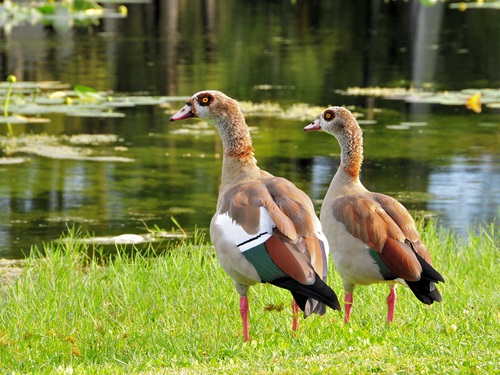
Although golf courses have always been intertwined with nature, they haven’t always been sustainable or wildlife-friendly. When these highly managed landscapes were first designed and built, huge amounts of earth were excavated and dumped in other places, thousands of gallons of water were used on fairways and greens, and fertilizers, pesticides and rodenticides were freely used.
These days, however, wildlife conservation on golf courses is becoming a hot topic as more players, course managers and golf course architects are taking a closer look at how these spaces can be more eco-friendly and serve as havens for biodiversity.
“The best thing about this shift towards conservation is that it changes nothing for the golfer. Anybody can step onto a golf course, modern or historic, and play an enjoyable round of golf without being affected by the measures taken to boost eco-friendliness—but you might be lucky enough to spot a bit of wildlife on the course itself,” writes Jordan Fuller for Green Lodging News.
Fuller notes that once a golf course has been designed to accommodate the area’s natural flora and fauna, measures need to be put in place to implement sustainable practices to keep the course eco-friendly. Steps include planting more native trees and plants, creating more bodies of water, leaving rough areas unmown, installing nesting boxes, avoiding the use of pesticides, and creating off-limits areas for golfers.
The USGA also points out that golf courses can provide valuable wildlife habitat, urban cooling, and stormwater management—especially in developed areas where green space is increasingly limited.
“Golf courses are often portrayed as an environmental detriment used only by a select group of wealthy people, but the facts tell a different story,” according to the USGA. “Extensive research has identified numerous environmental benefits of golf courses, along with the recreational and economic value they bring to our communities. In the end, the environmental value of each individual golf course depends on its location and how it is designed and managed. Golf courses are highly visible, seemingly large swaths of land, but they represent less than 0.1% of all U.S. land area.”
Stories abound about endangered wildlife species not only existing on golf courses, but thriving. Golf Course Management magazine cites the example of how Eglin Golf Course in Florida helped a multi-agency effort to turn the Okaloosa Darter’s fortunes around. The 2-inch fish is found almost exclusively in the streams at Eglin Air Force Base, and was listed as endangered in 1973. Thanks to the work of the Air Force, the Florida Fish and Wildlife Conservation Commission and others, the Okaloosa Darter was the first species to be recovered from military lands. The fish’s population has since swelled to an estimated 600,000.
Meanwhile, Golf Digest lauds the efforts Fairview Country Club in Greenwich, Conn., which boasts approximately 86 wildlife species and a wide array of flora, including 52 tree species.
And across the pond in Great Britain, CNN recently reported on a tiny endangered toad stopping play at the Open Championship. “The hopping arrival of one of Britain’s rarest amphibians at Royal Liverpool’s 13th green led to a delay in proceedings during the third round of the major, as only one trained member of the club’s staff can handle the natterjack toad.” Measuring just six to eight centimeters, weighing between four and 19 grams, and only found at a select few coastal spots in England and Scotland, according to British charity The Wildlife Trusts, the natterjack toad is a European protected species.
 But what happens when a golf course is closed or abandoned? CNN reports that in the U.S., with the number of course closures outweighing new openings every year since 2006, some are questioning how these huge spaces should be used, and asking whether, instead of golf, nature should be left to run its course.
But what happens when a golf course is closed or abandoned? CNN reports that in the U.S., with the number of course closures outweighing new openings every year since 2006, some are questioning how these huge spaces should be used, and asking whether, instead of golf, nature should be left to run its course.
“Conservation nonprofits and local authorities are looking to acquire golf courses that have been abandoned due to high maintenance costs, low player numbers or other reasons, and repurpose them into landscapes that boost biodiversity and build natural defenses against climate change,” reports CNN. For example, the 195-acre Valley View Golf Course in Akron, Ohio is being restored and rewilded. The project connected three local parks and created 1,900 contiguous acres of green space.
In San Geronimo, Calif., an 18-hole course in Marin County is located on two waterways that are home to endangered coho salmon and steelhead trout. In 2018, The non-profit Trust for Public Land (TPL) purchased the 157-acre site for $8.9 million, renamed it San Geronimo Commons, and began converting the area back into its natural state. The organization says the rewilding process could take up to 10 years, but there are signs wildlife is already bouncing back, with bobcats spotted roaming the area.
There are many more examples of such efforts both here and abroad. As Fuller of Green Lodging News opines, “Mixing golf and biodiversity is a match made in heaven if done right. We encourage golfers to explore eco-friendly golf courses and see how they can change their own game to become more environmentally friendly. And if you’re a golf course manager or golf architect, it’s absolutely worth investing in eco-friendly measures. It’s not just good for the environment, it’s a mark of honor on your golf course.” In fact, several years ago, golf courses in California responded to drought conditions by instituting water-saving practices, as noted by the Golf Course Superintendants Association of America.
And in case you thought this was just an American things, think again. Just ahead of the Olympics, international officials gathered at Le Golf National, the host venue of the Paris 2024 Olympic golf venue to celebrate the Sports for Nature Framework. Sports for Nature is a joint initiative of the International Union for Conservation of Nature (IUCN), International Olympic Committee (IOC), United Nations Environment Programme (UNEP), the Secretariat of the Convention on Biological Diversity (CBD) and Dona Bertarelli Philanthropy. The initiative champions the environment and recognizes athletes and event owners as stewards.
“We are incredibly proud to join the Sports for Nature Framework as nature is part of the DNA of golf,” said Christophe Muniesa, General Manager of the French Golf Federation. “We know that the beautiful nature in our golf courses is diversified, rich but also under threat. We have long been committed to preserving it and want to ensure that golf courses are an integral part of the solution to preserve the environment, alongside our partner the National Museum of Natural History. The Sports for Nature Framework will allow us to promote and share our best practices, raise awareness among golfers but also inspire them to progress."

